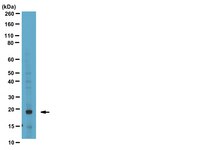AB10424 Sigma-AldrichAnti-Phospho-Bad (Ser99) Antibody
This Anti-Phospho-Bad (Ser99) Antibody is validated for use in WB for the detection of Phospho-Bad (Ser99).
More>> This Anti-Phospho-Bad (Ser99) Antibody is validated for use in WB for the detection of Phospho-Bad (Ser99). Less<<Recommended Products
Overview
| Replacement Information |
|---|
Key Spec Table
| Species Reactivity | Key Applications | Host | Format | Antibody Type |
|---|---|---|---|---|
| H | WB | Rb | Purified | Polyclonal Antibody |
| References |
|---|
| Product Information | |
|---|---|
| Format | Purified |
| Control |
|
| Presentation | Purified in PBS with 0.09% NaN3. |
| Quality Level | MQ100 |
| Applications | |
|---|---|
| Application | This Anti-Phospho-Bad (Ser99) Antibody is validated for use in WB for the detection of Phospho-Bad (Ser99). |
| Key Applications |
|
| Physicochemical Information |
|---|
| Dimensions |
|---|
| Materials Information |
|---|
| Toxicological Information |
|---|
| Safety Information according to GHS |
|---|
| Safety Information |
|---|
| Storage and Shipping Information | |
|---|---|
| Storage Conditions | Store at 2-8°C for 6 months from date of receipt. For long term storage, store at -20°C. |
| Packaging Information | |
|---|---|
| Material Size | 100 µg |
| Transport Information |
|---|
| Supplemental Information |
|---|
| Specifications |
|---|
| Global Trade Item Number | |
|---|---|
| Catalogue Number | GTIN |
| AB10424 | 04053252326332 |
Documentation
Anti-Phospho-Bad (Ser99) Antibody MSDS
| Title |
|---|
Anti-Phospho-Bad (Ser99) Antibody Certificates of Analysis
| Title | Lot Number |
|---|---|
| Anti-Phospho-Bad (Ser99) | 2482223 |
| Anti-Phospho-Bad (Ser99) - 2029183 | 2029183 |
| Anti-Phospho-Bad (Ser99) - 3277105 | 3277105 |
| Anti-Phospho-Bad (Ser99) - NG1595579 | NG1595579 |
| Anti-Phospho-Bad (Ser99) - NG1740984 | NG1740984 |
| Anti-Phospho-Bad (Ser99) -2515380 | 2515380 |







